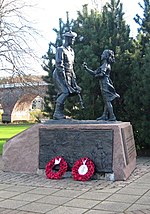Perth Art Gallery
Category B listed buildings in Perth and KinrossDecorative arts museums in ScotlandDefunct museums in ScotlandGlass museums and galleriesListed buildings in Perth, Scotland ... and 2 more
Local museums in ScotlandNatural history museums in Scotland

Perth Art Gallery is the principal art gallery and exhibition space in the city of Perth, Scotland. It is located partly in the Marshall Monument, named in memory of Thomas Hay Marshall, a former provost of Perth.The building was formerly known as Perth Museum and Art Gallery, ceasing to be so in anticipation of the new Perth Museum opening within Perth City Hall.
Excerpt from the Wikipedia article Perth Art Gallery (License: CC BY-SA 3.0, Authors, Images).Perth Art Gallery
Via Ca' Bianca,
Geographical coordinates (GPS) Address Nearby Places Show on map
Geographical coordinates (GPS)
| Latitude | Longitude |
|---|---|
| N 56.3983 ° | E -3.4283 ° |
Address
Stadio Comunale Carlo Speroni
Via Ca' Bianca
21057
Lombardei, Italien
Open on Google Maps









